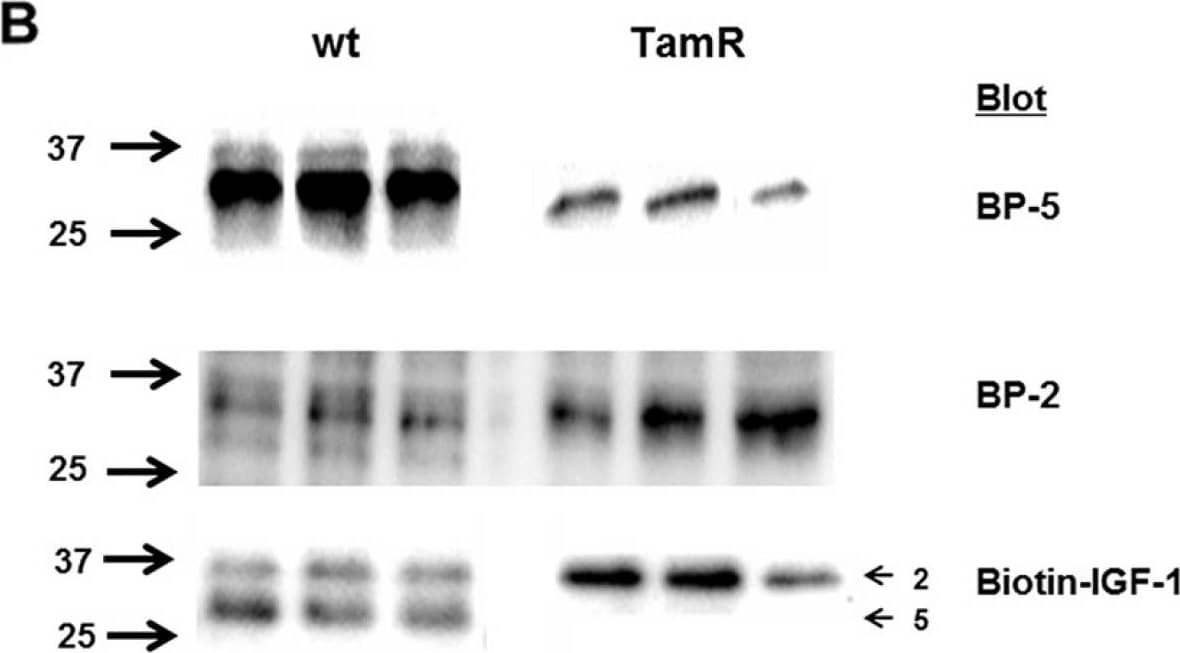Human IGFBP-5 Antibody
R&D Systems, part of Bio-Techne | Catalog # MAB8751

Key Product Details
Species Reactivity
Validated:
Cited:
Applications
Validated:
Cited:
Label
Antibody Source
Product Specifications
Immunogen
Glu28-Glu272
Accession # P24593
Specificity
Clonality
Host
Isotype
Scientific Data Images for Human IGFBP-5 Antibody
Detection of Human Human IGFBP-5 Antibody by Western Blot
(A) Elisa determination of IGFBP-2 and -5 concentrations in conditioned medium (CM) from wt and TamR MCF-7 cell lines. Data represent mean ± SD (n = 3). Experiments were repeated on three separate occasions. *p < 0.001, **p < 0.0001 (Student's unpaired t-test). (B) Western blot (upper two panels) and Ligand blot (lower panel) identifies IGFBP-2 (upper arrow Ligand blot) and IGFBP-5 (lower panel Ligand blot) in CM from wt and TamR MCF-7 cells. (C) Densitometric analysis of Western blots for IGFBP-2 (upper graph) and IGFBP-5 (lower graph) band intensity. Triplicate lanes per blot were analysed for both wt and TamR conditioned media using Image Lab software. Data are presented as mean +/− SD (n = 3) of Arbitrary Unit (AU) intensity. This experiment was repeated 3 times with similar results in each instance. *p < 0.005 TamR v MCF-7 Students t-test. GraphPad Prism 5.0. Image collected and cropped by CiteAb from the following publication (https://pubmed.ncbi.nlm.nih.gov/27050076), licensed under a CC-BY license. Not internally tested by R&D Systems.Applications for Human IGFBP-5 Antibody
Western Blot
Sample: Recombinant Human IGFBP-5 (Catalog # 875-B5)
under non-reducing conditions only
Human IGFBP-5 Sandwich Immunoassay
Formulation, Preparation, and Storage
Purification
Reconstitution
Formulation
Shipping
Stability & Storage
- 12 months from date of receipt, -20 to -70 °C as supplied.
- 1 month, 2 to 8 °C under sterile conditions after reconstitution.
- 6 months, -20 to -70 °C under sterile conditions after reconstitution.
Background: IGFBP-5
The superfamily of insulin-like growth factor (IGF) binding proteins include the six high-affinity IGF binding proteins (IGFBP) and at least four additional low-affinity binding proteins referred to as IGFBP related proteins (IGFBP-rP). All IGFBP superfamily members are cysteine-rich proteins with conserved cysteine residues, which are clustered in the amino- and carboxy-terminal thirds of the molecule. IGFBPs modulate the biological activities of IGF proteins. Some IGFBPs may also have intrinsic bioactivity that is independent of their ability to bind IGF proteins. Post-transitional modifications of IGFBP, including glycosylation, phosphorylation and proteolysis, have been shown to modify the affinities of the binding proteins to IGF. Human IGFBP-5 cDNA encodes a 272 amino acid (aa) residue precursor protein with a putative 20 aa residue signal peptide that is processed to generate the 252 aa residue mature protein that is post-translationally modified by O-glycosylations and serine phosphorylations. IGFBP-5 is expressed by fibroblasts, myoblasts and osteoblasts, making it the predominant IGFBP found in bone extracts. IGFBP-5 has a strong affinity for hydroxyapatite, allowing it to bind to bone cells. When bound to extracellular matrix, IGFBP-5 is protected from proteolysis and potentiates IGF activity, but when it is soluble, IGFBP-5 is cleaved to a biologically inactive 21 kDa fragment.
References
- Jones, J.I. and D.R. Clemmons (1995) Endocrine Rev. 16:3.
- Kelley, K.M. et al. (1996) Int. J. Biochem. Cell Biol. 28:619.
Long Name
Alternate Names
Gene Symbol
UniProt
Additional IGFBP-5 Products
Product Documents for Human IGFBP-5 Antibody
Product Specific Notices for Human IGFBP-5 Antibody
For research use only
